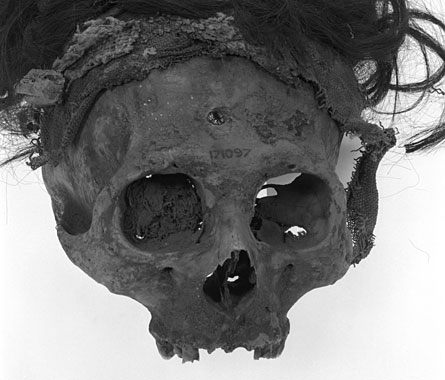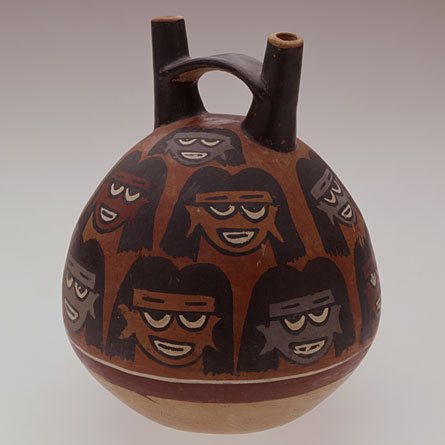In South America’s ancient Nasca culture, some local folk literally lost their heads so that everyone else might fill their bellies. The Nasca obtained trophy heads, human skulls modified in various ways and intended to spur successful farming, from their own people, not from foreigners slain in battles and raids as was practiced by the Inca and other prehistoric societies of that region, a new study finds.


Earlier analyses of paintings on Nasca pottery had suggested that members of this culture believed that the taking of trophy heads provided supernatural power needed for crop growth. Since the first Nasca trophy heads were discovered nearly 100 years ago, scientists have debated whether these items came from vanquished enemies or from local individuals thought to represent venerated Nasca ancestors.
“Rather than obtaining heads from enemy warriors through geographic expansion or warfare as seen in other parts of the world, we argue that Nasca trophy heads derived from the local Nasca population,” says archaeologist and study director Kelly Knudson of Arizona State University in Tempe.
The finding comes from an analysis of the diet-related substances that had collected and remain in the teeth of unearthed Nasca trophy heads. Comparing these substances with those in the teeth of skeletons known to be from Nasca individuals shows that one set of trophy heads came from the Nasca themselves rather than from outsiders, Knudson’s team reports in a paper published online December 11 in the Journal of Anthropological Archaeology.
Such data can’t yet pinpoint the geographic origins of the people whose heads became Nasca trophy heads, nor can the data rule out the possibility that the trophy heads were acquired in fights between local Nasca groups, remarks anthropologist William Isbell of Binghamton University in New York. “We can’t draw any final conclusions from this new study, but the results make it more likely that these severed heads were ancestors and not enemies,” Isbell says.
Nasca culture existed in the coastal lowlands of what is now southern Peru from about 2,000 to 1,250 years ago. The society included a large ceremonial city that hosted pilgrimages, feasts and other ritual events. Political complexity and warfare increased during the culture’s final 200 years.
Much archaeological evidence suggests that local Nasca groups sometimes engaged in battles and raids among themselves, in line with Knudson’s finding of local origins for trophy heads, comments archaeologist Kevin Vaughn of Purdue University in West Lafayette, Ind. As the Nasca culture neared its end, various groups built well-protected, widely spaced settlements, probably in response to internal conflicts, notes anthropologist Katharina Schreiber of the University of California, Santa Barbara.
Nasca sites of various ages have yielded more than 150 trophy heads, often found in caches of as many as 48 skulls, in graves as offerings to the dead and in public buildings. Most trophy skulls come from men, but some are from women and teenagers.
Knudson and her colleagues studied 16 trophy heads found at six Nasca sites by the late anthropologist Alfred Kroeber in 1925 and 1926. All the heads had been modified in the same way, with a hole drilled in the forehead for a carrying cord. Many Nasca trophy heads contain comparable forehead holes. Kroeber’s finds are kept at The Field Museum in Chicago.
Biochemical profiles of tiny amounts of tooth enamel taken from these trophy heads were compared to corresponding data for 13 intact Nasca skeletons that had already been excavated from either of three Nasca cemeteries. The scientists measured levels of key forms of strontium, oxygen and carbon in the ancient teeth, which were compared to baseline levels of these substances in rock formations, water, plants and small animals throughout the Nasca region.
Signature ratios of different forms of strontium, oxygen and carbon reflect where a person lived and what types of foods he or she consumed.
Overall, teeth from the trophy heads and from the comparison group displayed no substantial differences in the ratios of these substances. It’s thus likely that individuals from both groups lived in the Nasca region, Knudson says.
In support of that view, an unpublished investigation by study coauthor Kathleen Forgey of Indiana University Northwest in Gary indicates that mitochondrial DNA sequences extracted from the Kroeber trophy heads closely resemble corresponding genetic sequences from intact Nasca skeletons.
Paintings on pottery from late Nasca periods show warriors holding or wearing trophy heads. “It is possible that warfare was a more common part of trophy taking toward the end of the Nasca culture,” Knudson says. Further biochemical studies of trophy heads can address that issue, in her view.







